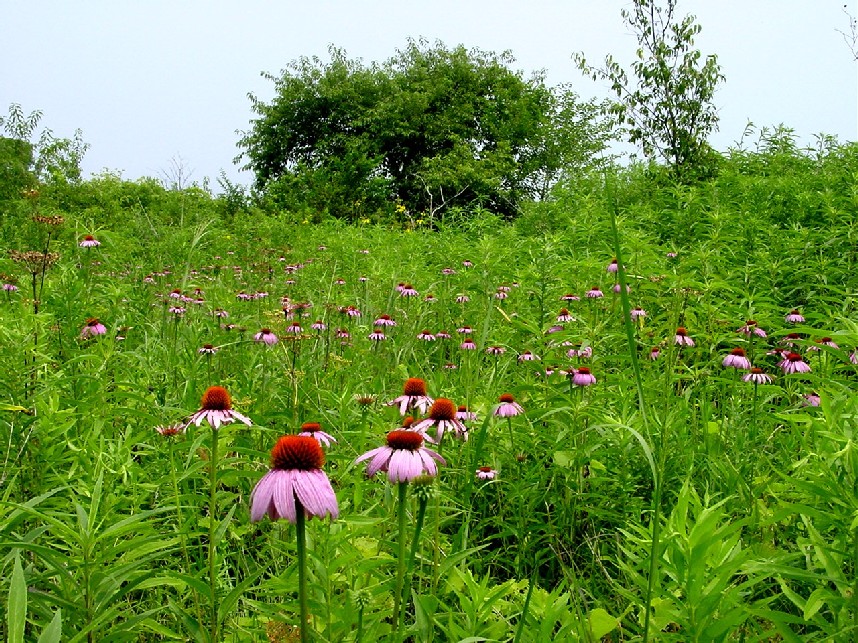Cedarville to London (Ohio)
John E. Silvius, Professor of Biology

Cedarville to London (Ohio)
John E. Silvius, Professor of Biology

| Grasses | White Flowers | Red or Violet Flowers | Yellow or Orange Flowers |
| Big Bluestem1 | Bastard-Toadflax6 | Obedient Plant11 | Butterfly Weed16 |
| Little Bluestem2 | Culver's Root7 | Purple Coneflower12 | Gray-Headed Coneflower17 |
| Indian Grass3 | Indian Plantain8 | Royal Catchfly13 | Hairy Wingstem18 |
| Prairie Cordgrass4 | Starry Campion9 | Wild Bergamot14 | Prairie Dock19 |
| Switchgrass5 | Virginia Mtn.-Mint10 | Queen of the Prairie 15 | Whorled Rosenweed20 |
The above photo of Purple Coneflower, Echinacea purpurea, like some of the photos shown below feature plant species of the remant prairie community along which cyclists, pedestrians, and adjacent highway motorists currently enjoy or will soon enjoy when the bikeway is extended from South Charleston east to London, Ohio. As you travel the bikeway, please observe and photograph the wildflowers but do not pick or otherwise harm these historic treasures of presettlement Ohio which survive only in these narrow confines that have not been plowed or paved.
1Big Bluestem (Andropogon gerardii) -- a
chief grass of tallgrass prairie, as seen at "County Line" remnant prairie
looking West along U.S.
42 near Greene-Clark Co. Line.
Big
Bluestem -- here in an experimental zone, it is protected from
summer mowing in cooperation with the
Ohio Dept. of Transportation
Big
Bluestem flower spikes -- this species is sometimes called "turkey
foot" because of the resemblance
of these floral spikes to
a turkey's foot
Big
Bluestem -- Along the "Prairie Grass Trail " many friends such as
Richard Ware (formerly of Vermont)
and Harold Kendall, Sr.
(formerly of South Dakota, now in glory) will meet and enjoy this slice
of remnant prairie in Ohio.
2Little Bluestem (Schizachyrium scoparium)
as seen in "Little Bluestem" remnant prairie west of South Charleston,
Ohio.
3Indian Grass (Sorghastrum nutans) -- a beautiful
stand in "Selma Prairie" remnant between U.S. 42 and "Prairie Grass Trail"
Indian Grass -- as seen
in "Selma Prairie" in late August
and in September as bikeway nears completion
4Prairie Cordgrass (Spartina pectinata) favored
in low damp soils as shown here between
U.S. 42 and bikeway.
5Switchgrass (Panicum virgatum) has a somewhat
delicate, open-branched inflorescence.
6Bastard-Toadflax (Comandra umbellata) grows
from horizontal underground rhizomes that, in partnership with a fungus,
can form haustoria that
attach to host plants and enable the toadflax to absorb nutrients.
7Culver's Root (Veronicastrum virginicum)
has prominent, terminal spikes of tiny white flowers and grows in dry,
upland woods and prairies.
8Indian Plantain (Cacalia atroplicifolium)
seen also in a typical habitat.
9Starry Campion (Silene stellata).
10Virginia Mountain-Mint (Pycnanthimum virginianum)
as seen growing with Compass Plant (large leaves).
11Obedient Plant (Physostegia virginiana)
12Purple Coneflower (Echinacea purpurea)
13Royal Catchfly (Silene regia) is an attractive,
red-flowering species whose sticky exudates discourage
insects that choose to land on the plant;
instead, the red flowers attract hummingbirds which hover.
14Wild Bergamot (Monarda fistulosa) a fragrant
member of the mint family.
15Queen of the Prairie (Filipendula rubra) of the rose family; photo taken near Selma, OH.
16Butterfly-weed (Asclepias tuberosa) provides
a good nectar source for Monarch Butterfly and others.
17Gray-Headed Coneflower (Ratibida pinnata)
is one of the more common coneflowers in bikeway remnants.
18Hairy Wingstem (Verbesina helianthoides)
and as seen also in a typical habitat
19Prairie Dock (Silphium terebinthinaceum,
Pinnatifid Variety) seen also in a typical
habitat
20Whorled Rosenweed (Silphium trifoliatum)
-- with U.S. 42 and Selma Rd. crossing in background
Return to "Wildflowers of Cedarville Area"
Return to
"Botany and Ecology Research"